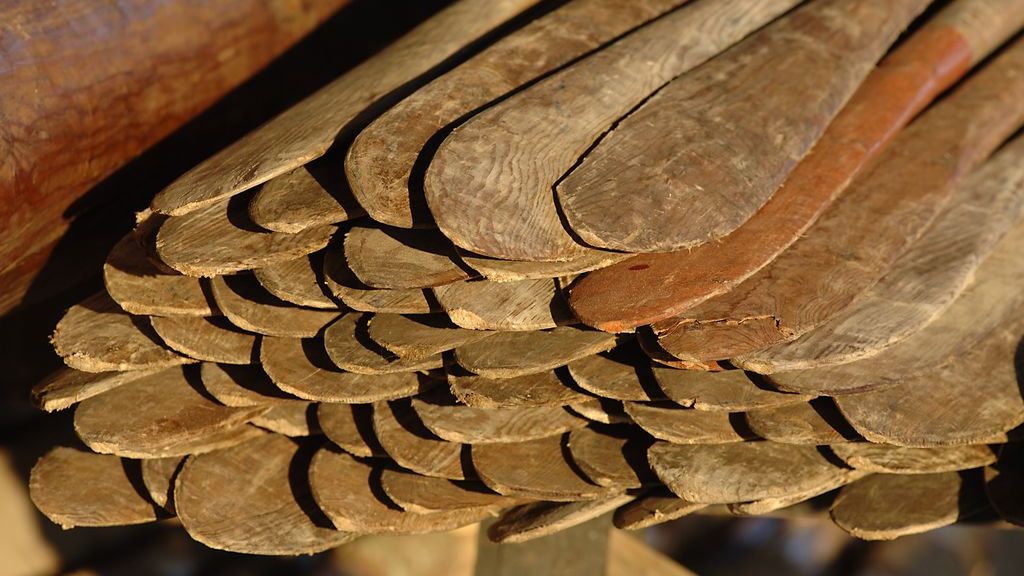The first sailing trip of the year didn’t go quite as planned, when Sea Stallion sailed out of the Museum harbour on the 4th of May. The 30m long ship sprang a leak under the waterline and the crew had to return to harbour and empty the ship of ballast while the boatbuilders from the Museum’s boatyard immediately began investigating the extent of the problem.
It transpired that the 6th and 7th strakes on the port side had cracked roughly amidships, in the area around the mast. Sea Stallion was taken on land and the boatbuilders replaced the cracked planking. The ship was launched for the second time this year, ready for the coming sailing season.
However, the problems with the hull quickly reappeared. After a trip to Holbæk, where Sea Stallion and its crew took part in Træskibs Sammenslutnings Whitsun Regatta, it was noticed that several of the of the nails and spikes in the mast area had become loose.
An old stallion
There can be several possible explanations for why this damage occurred, but one thing is clear: after almost 15 years on the water, Sea Stallion is getting older and can therefore no longer tolerate the same stresses it could when newly-built.
Sea Stallion has many sea miles under its keel. The ship’s longest voyage was the trial voyage from Roskilde to Dublin and back again in 2007 and 2008. Since then, Sea Stallion and its volunteer crew have sailed many summer voyages around the Danish coast and time is beginning to take its toll on the hull.
The original Viking ships from Skuldelev all have traces of repair and year-ring dating of the ships’ planking from the construction phase and later repairs demonstrate that the original ships all underwent repair after ca. 15 years of use. The ships had an estimated period of use of between 20 and 40 years, before being scuttled in the fjord as a barrier across a sailing channel, from which they were excavated in 1962. Another securely dated example of the period of use for a Viking ship is the Oseberg ship, which was in use for 14 years before being used as a burial ship. These archaeological finds tell us that the lifespan of a Viking ship was – relatively speaking – short, and perhaps shorter than we imagine it as being today.
The archaeological experiment: ’Let’s see what it means in terms of…’
In addition to repairing the vulnerable parts of the ship, the Museum has also decided to make some changes in order to minimise the stresses on the ship while sailing.
The most fundamental change is the fact that the mast will be reduced by 1.5m. This change will help to greatly reduce the stresses on the hull – by reducing the height of the mast, you reduce the stress as this action also induces a series of other related changes. A shorter mast requires a shorter sail – and therefore a sail with a lesser sail area. This in turn means that the ship can sail with less ballast, which means less energy is required to move the ship through the water.
Archaeologically speaking, the height of the masts on Viking Age ships is an unknown factor, so there is room for experiment. Seen from the Viking Ship Museum’s perspective, it’s an interesting archaeological experiment as we will now be sailing with a ship with a shorter mast and a shorter sail. This gives us the opportunity to explore the impact this will have on the hull’s construction, the ship’s ability to tack and wear, its movement in high seas and how easy – or difficult – it is to row.
A busy time at the boatyard
If you visit the Museum at the moment, you’ll see the boatbuilders in full swing with making the final adjustments that reducing the mast height entails. Before Sea Stallion can sail out on its summer voyage in weeks 28 and 29, they must:
- Remove the mast and reduce its height
- Shorten the after stay
- Repair the damage that has taken place
- Remove at least 1.5 tonnes of ballast from the ship
- Widen the hole in the mast partner, so there will be 15mm space around the mast
Summer voyage with an experimental archaeological focus
The title for this year’s summer voyage with the 50 volunteer crewmembers will be ‘testing, checking and gaining experience’. The sailing will take place close to the coast in the inner Danish waters, where the boat guild will have to use time to get to know this ‘new’ version of the Sea Stallion.
In addition to the normal log books, the guild will also carry out documentation with focus on the hull, sail and rigging, where their observations will be written down and supported by photo and film, to see what impact the changes have had on Sea Stallion. All of this will contribute to the on-going experimental archaeological work the Sea Stallion – and with the upcoming reconstruction work with Roskilde 6, the world’s longest Viking ship.
Facts about the Viking Ship The Seastallion fra Glendalough:
Sea Stallion from Glendalough is a reconstruction of the Viking ship, Skuldelev 2, which is on display in the Viking Ship Hall in Roskilde. Skuldelev 2 was built in the Dublin area around 1042 and bears witness to the contact between Denmark and Ireland in the Viking Age. Sea Stallion was built as an archaeological experiment at the Viking Ship Museum’s boatyard in 200 – 2004. During the construction, the same materials and methods were used as those employed during the construction of the original ship.
From 2007 - 2008, Sea Stallion carried out a trial voyage from Roskilde to Dublin and back again, with a volunteer crew of men and women from 10 different countries. 2,482 sea miles were travelled, in order to test the reconstruction.
The voyage was a success. The ship’s sailing capabilities proved to be good and it held an average speed of 6-8 knots.



